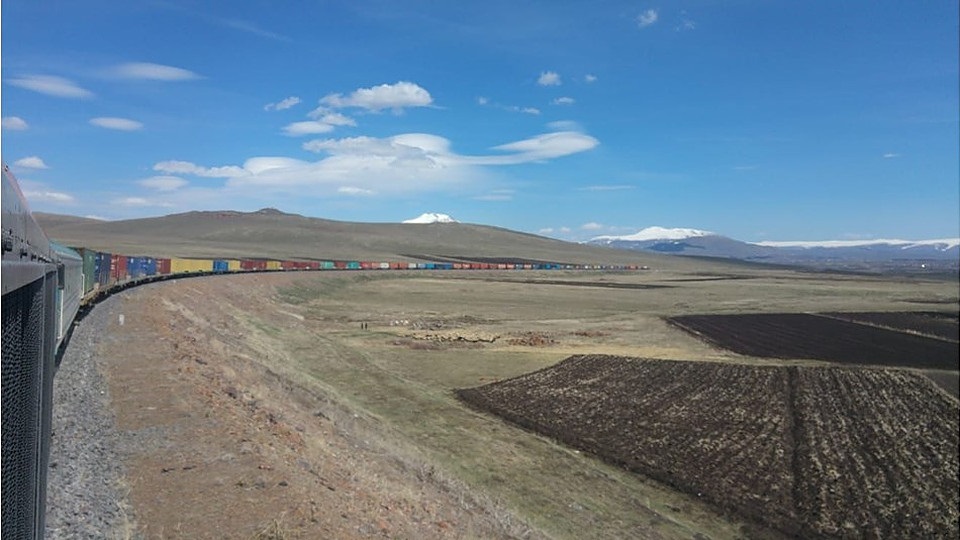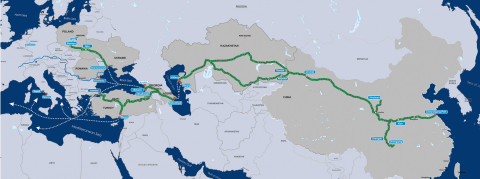Capacity or not, the Middle Corridor is on the rise

The rail freight volumes passing through the Middle Corridor (via Kazakhstan, Azerbaijan and Georgia) increased by 52 per cent last year. This surge is expected to be even higher this year, due to the increased interest in the corridor as an alternative multimodal route between Europe and China.
The figures of 2021 were presented by Ady Container, a subsidiary of Azerbaijan Railways and an active player on the Middle Corridor. The route connects China and Europe via Kazakhstan, the Caspian Sea, Azerbaijan, Georgia and and then Turkey or the Black Sea, depending on the final destination.
Although it only accounts for a small percentage of the total volumes (3-5 per cent) moving between China and Europe, the volumes are steadily on the rise. Whereas the figures of Ady Container show volumes of around 19,000 thousand TEUs in 2021, this number had increased to over 29,000 thousand TEUs in 2021, good for a 52 per cent rise.
Middle Corridor as an alternative
The Middle Corridor is currently in the spotlight as it provides one of the few alternatives to transit traffic on the main route of the New Silk Road, the route transiting through Russia. As companies decide to avoid this route, based on moral grounds, payment difficulties or fear of security breaches, they find in the Middle Corridor another option to move cargo by rail.
However, the corridor that has been there for many years is much less competitive compared to the main route. This is because there are seas in between and the rates are still relatively high. There seems to be little harmonisation along the route. This all makes that the corridor is not quite ready yet for the rising figures. “At the moment, the corridor cannot handle the demand from the northern side”, said Cankat Yildiz from Middle Corridor Logistics in a recently held webinar.
Congestion
But as it looks today, there is little that can be done to prevent cargo shippers from looking into the route. The sudden interest in the Middle Corridor has even led to reports of congestion on the corridor and this poses a challenge to logistics providers, who want to offer solutions, but not too many, as capacity is starting to be limited.
Although figures of the first two months of this year are not yet provided for the entire corridor, the Caspian Sea has already reported a surge in freight transport. Kazakhstan’s volume of cargo transported via its ports during the first two months of 2022 reached 157,940 tons, 5.4 per cent more compared to the same period of last year, reports the site Silk Road Briefing. All three ports of Kazakhstan are on the Caspian Sea.
More oil on the route
ADY Express, a structural subdivision of Azerbaijan Railways, is also increasing the volume of cargo traffic along the corridor. The company is planning to transport fuel oil from Kazakhstan to the Georgian port of Batumi in March 2022.
“The fuel oil will be loaded into tank cars at the Tekesu station in Kazakhstan and then delivered to the port of Alat, from where it will be transported by rail to the port of Batumi. In addition, part of the cargo will be transported along the route Kazakhstan-Russia-Azerbaijan-Georgia”, the company said.
Also Kazakhstan reports a surge in transit volumes. The volume of railway freight traffic has increased by 10 per cent and the total volume of transit traffic by 20 per cent in the two months of 2022”, the Kazakh Prime Minister Alikhan Smailov said yesterday.
Time for action
Until now, players along the Middle Corridor have been wary to make substantial investments due to a lack of sufficient demand. This has partly led to the capacity limitations, and to the relatively high tariffs.
Now that shippers are resorting to the corridor en masse, the parties involved have some catching up to do. We need to create solutions, said Yildiz during the webinar.
Do you want to hear more about the possibilities on the Middle Corridor, or challenges of the logistics industry today? On 6 April we organise the RailFreight Summit Special Edition in Brussels. Tickets are still available and can be found here.
You just read one of our premium articles free of charge
Want full access? Take advantage of our exclusive offer







